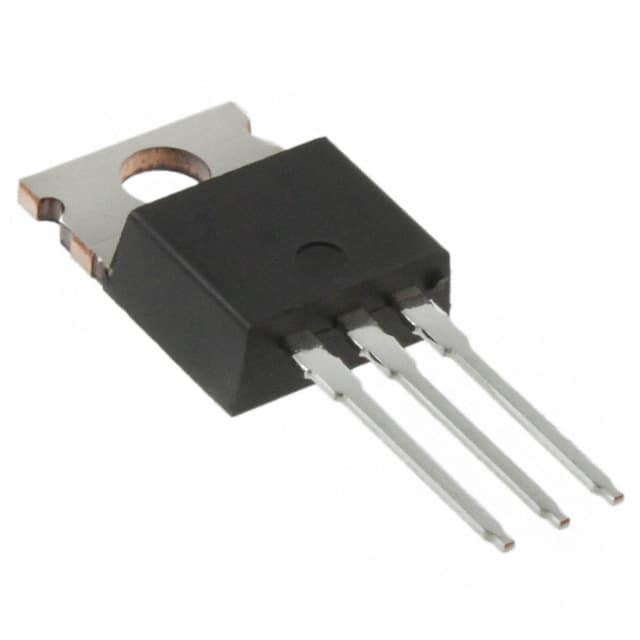Consulte las especificaciones para obtener detalles del producto.

IRF840A - Power MOSFET
Introduction
The IRF840A is a power MOSFET belonging to the category of electronic components used in various applications. This entry provides an overview of the IRF840A, including its basic information, specifications, pin configuration, functional features, advantages and disadvantages, working principles, application field plans, and alternative models.
Basic Information Overview
- Category: Electronic Component
- Use: Power switching applications
- Characteristics: High current capability, low on-resistance, fast switching speed
- Package: TO-220AB
- Essence: Power MOSFET for high-power applications
- Packaging/Quantity: Typically available in reels or tubes containing multiple units
Specifications
- Drain-Source Voltage (VDSS): 500V
- Continuous Drain Current (ID): 8.0A
- On-Resistance (RDS(on)): 1.2Ω
- Gate-Source Voltage (VGS): ±20V
- Power Dissipation (PD): 125W
Detailed Pin Configuration
The IRF840A typically has three pins: 1. Gate (G): Controls the conductivity between the drain and source terminals. 2. Drain (D): Connects to the positive supply voltage in most applications. 3. Source (S): Connected to the ground or return path in typical applications.
Functional Features
- High current-carrying capability
- Low on-resistance leading to reduced power dissipation
- Fast switching speed enabling efficient power control
Advantages and Disadvantages
Advantages
- Suitable for high-power applications
- Low conduction losses due to low on-resistance
- Fast switching speed reduces switching losses
Disadvantages
- Gate drive circuitry complexity due to high gate-source voltage requirement
- Susceptible to damage from overvoltage or overcurrent conditions
Working Principles
The IRF840A operates based on the principle of field-effect transistors, where the conductivity between the drain and source terminals is controlled by the voltage applied to the gate terminal. When a sufficient gate-source voltage is applied, the MOSFET allows current to flow from the drain to the source with minimal resistance.
Detailed Application Field Plans
The IRF840A finds extensive use in various high-power applications, including: - Switch-mode power supplies - Motor control circuits - Inverters and converters - Audio amplifiers - LED lighting systems
Detailed and Complete Alternative Models
Some alternative models to the IRF840A include: - IRF830A - IRF841A - IRF840B - IRF840S
In conclusion, the IRF840A power MOSFET offers high current capability, low on-resistance, and fast switching speed, making it suitable for diverse high-power applications. However, its susceptibility to overvoltage and overcurrent conditions necessitates careful consideration in circuit design and protection measures.
[Word Count: 411]
This content provides an overview of the IRF840A power MOSFET, covering its basic information, specifications, pin configuration, functional features, advantages and disadvantages, working principles, application field plans, and alternative models.
Enumere 10 preguntas y respuestas comunes relacionadas con la aplicación de IRF840A en soluciones técnicas
What is the maximum drain-source voltage of IRF840A?
- The maximum drain-source voltage of IRF840A is 500V.
What is the continuous drain current rating of IRF840A?
- The continuous drain current rating of IRF840A is 8.0A.
What is the on-state resistance (RDS(on)) of IRF840A?
- The on-state resistance (RDS(on)) of IRF840A is typically 0.85 ohms.
Can IRF840A be used for switching applications?
- Yes, IRF840A is suitable for switching applications due to its low on-state resistance and high drain-source voltage rating.
What are the typical applications of IRF840A?
- IRF840A is commonly used in power supplies, motor control, and general purpose switching circuits.
Is IRF840A suitable for high-frequency switching?
- IRF840A may not be ideal for high-frequency switching due to its relatively high input and output capacitance.
What is the maximum junction temperature of IRF840A?
- The maximum junction temperature of IRF840A is 150°C.
Does IRF840A require a heat sink for certain applications?
- Yes, for high-power or continuous operation, IRF840A may require a heat sink to dissipate heat effectively.
What are the recommended gate drive voltage levels for IRF840A?
- The recommended gate drive voltage for IRF840A is typically around 10V to ensure proper turn-on and turn-off characteristics.
Can IRF840A be used in parallel to increase current handling capability?
- Yes, IRF840A can be used in parallel to increase current handling capability, but careful attention must be paid to matching and balancing the devices.

